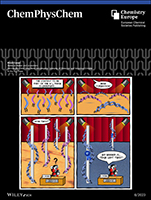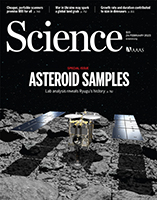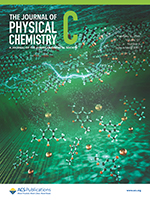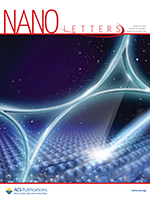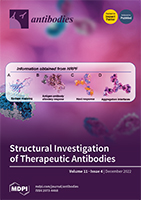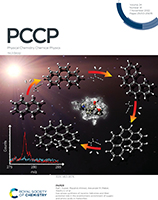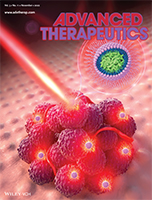Cartoon depiction of the formation of the heliconical chiral twist-bend nematic phase (N*TB) from its constituent bent molecules. The presence of a single enantiomer of the chiral, lactate-based liquid crystal dimers biases the formation of helices with only one handedness, unlike in the conventional NTB phase, observed for achiral molecules, for which the left- and right-handed helices are doubly degenerate. Read more »
Journal Covers
Macromolecular organic matter in samples of the asteroid (162173) Ryugu
We investigated the macromolecular organic matter in samples of the asteroid Ryugu—brought to Earth by the Hayabusa2 spacecraft—measuring its elemental, isotopic, and functional group compositions along with its small-scale structures and morphologies. Analytical methods used included spectro-microscopies, electron microscopy, and isotopic microscopy. Read more »
A Study on the Reaction Mechanism of a Model Organic Cathode in Magnesium-Ion Batteries
Battery and analytical studies of a model benzoquinone-type cathode reveal reversible structural transformations driven by a new precedence of a unique dissolution/precipitation mechanism and raise the question regarding its prevalence in other organic cathode batteries. Read more »
Dirac Nodal Line in Hourglass Semimetal Nb3SiTe6
Hourglass fermion in an electronic band structure is protected by the nonsymmorphic symmetry of a layered semimetal Nb3SiTe6. Angle-resolved photoemission spectroscopy demonstrates the band features of an hourglass fermion in k-space, such as band crossings and nodal loops. Read more »
Enhanced low-temperature proton conductivity in hydrogen-intercalated brownmillerite oxide
Solid oxide materials typically need high temperatures to allow appreciable ion transport, limiting their flexibility as electrolytes for energy devices. Lu et al. now show unusually high proton conductivity in a hydrogenated oxide between 40 °C and 140 °C, which they attribute to ordered vacancy channels and high proton concentrations. Read more »
Structural Investigation of Therapeutic Antibodies Using Hydroxyl Radical Protein Footprinting Methods
Well-known high-resolution structural methods are often used to characterize antibody structures, but many require specialized sample preparation that may perturb antibody structure. We describe here the relatively new method of hydroxyl radical protein footprinting, a solution-state method that can provide structural and kinetic information on antibodies or antibody–antigen interactions useful for therapeutic antibody design. Read more »
Gas-phase synthesis of racemic helicenes and their potential role in the enantiomeric enrichment of sugars and amino acids in meteorites
Molecular-beam experiments with isomer-selective photoionization via a targeted, vinylacetylene-mediated gas-phase reaction of aromatic helicenyl radicals coupled with electronic structure calculations and astrochemical modeling reveal an elegant synthetic route to racemic helicenes – ortho-fused polycyclic aromatic hydrocarbons (PAHs), in which benzene building blocks form helically-shaped molecules. Read more »
Surface Charge and Nanoparticle Chromophore Coupling to Achieve Fast Exciton Quenching and Efficient Charge Separation in Photoacoustic Imaging (PAI) and Photothermal therapy (PTT)
Organic semiconductor nanoparticles (OSNs) convert absorbed light into heat, and are commonly used in photothermal therapy and photoacoustic imaging. Here, the OAN, Y6, is shown to form strong intermolecular packing, manipulated by surface charge under restrained sizes, yielding new pi-pi stacking and fast exciton quenching. The temperature of the tumor area can rise to more than 70 degrees under NIR irradiation, which can effectively ablate a tumor. Read more »
Uncompetitive, adduct-forming SARM1 inhibitors are neuroprotective in preclinical models of nerve injury and disease
Researchers describe potent small-molecule inhibitors that are neuroprotective in preclinical models of nerve injury and disease. The cover depicts the destruction of an axon by the enzyme SARM1, shown disproportionately large to convey its catastrophic role in driving degeneration once it is activated upon injury. Read more »
Optical sensing of aqueous nitrate anion by a platinum(II) triimine salt based solid state material
Researchers present a new Pt(II) salt that enables the selective and quantitative measurement of aqueous nitrate anions without the need for pH adjustment. The method relies on the color change of the Pt(II) complex from yellow to red and an intense luminescence response, simplifying the detection process for on-site applications and expanding its applicability to broader matrices. Read more »
- « Previous Page
- 1
- …
- 4
- 5
- 6
- 7
- 8
- …
- 21
- Next Page »
